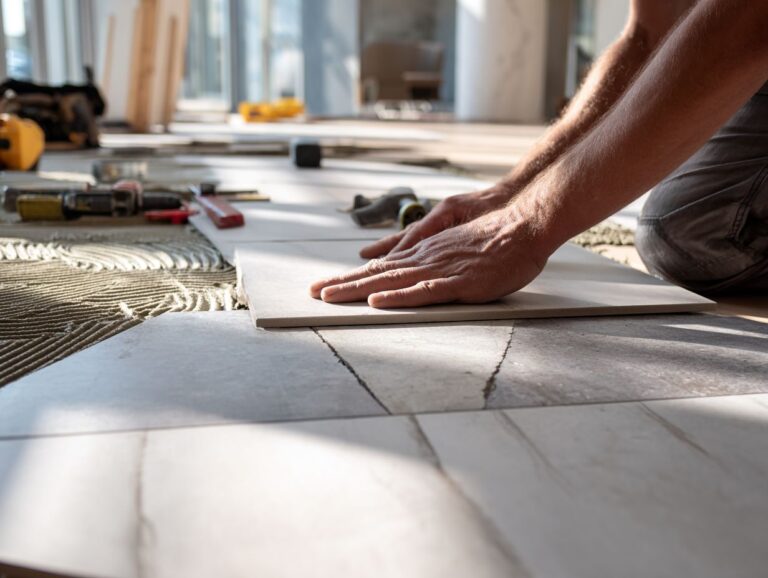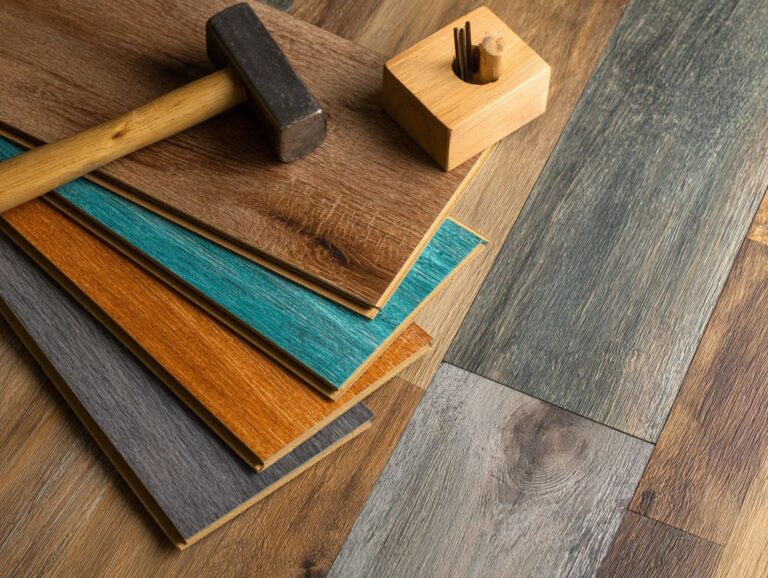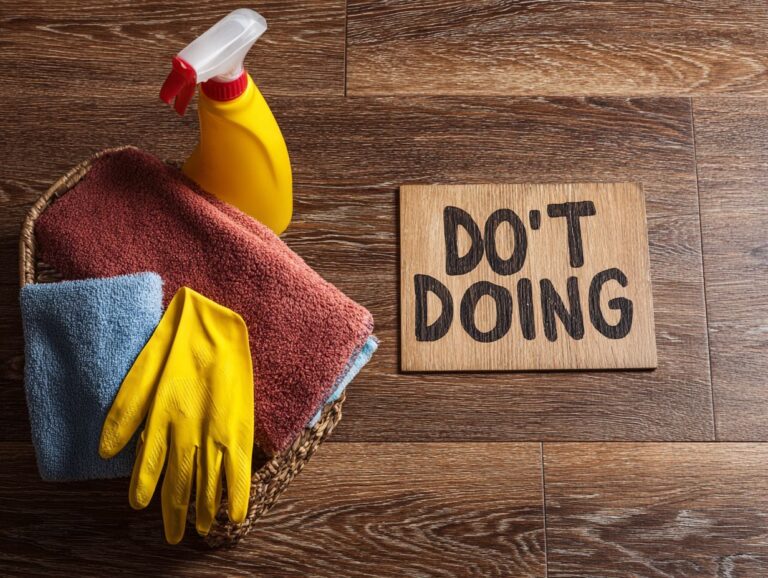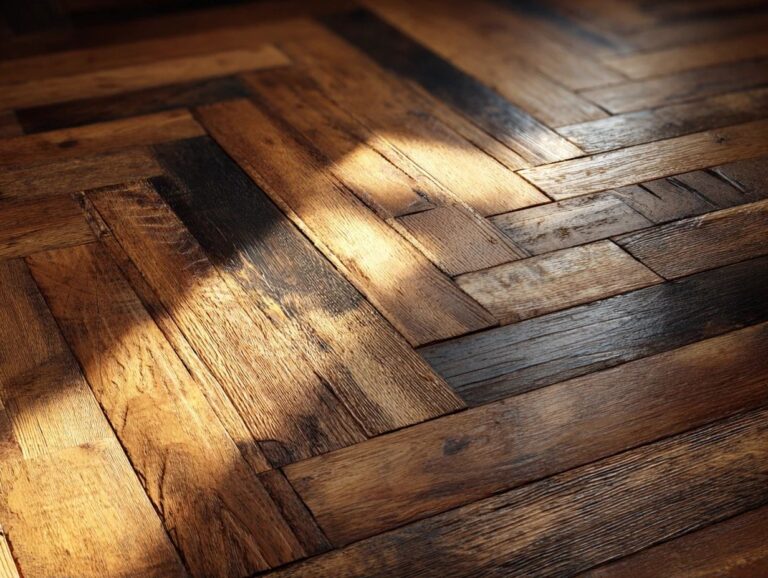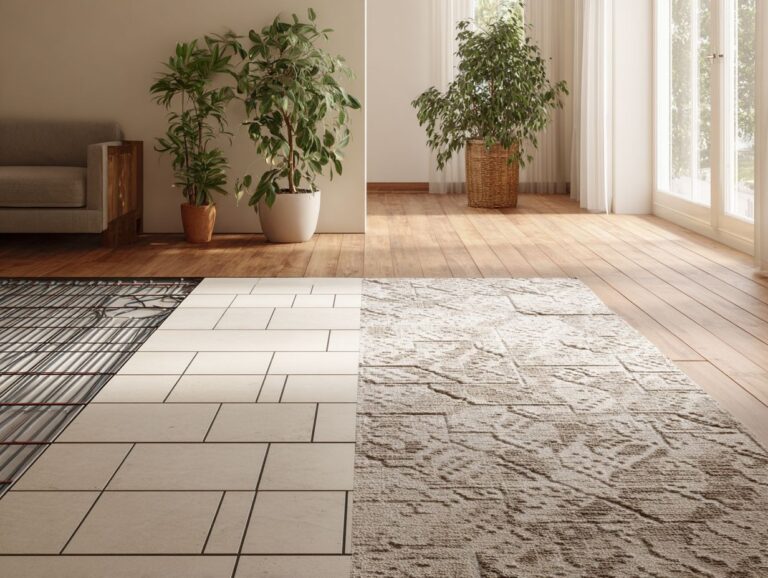Bamboo Flooring – Strand Woven vs Horizontal vs Vertical
Are you considering bamboo flooring for your home? With its impressive hardness and sustainable appeal, bamboo floors are a popular choice. However, misunderstandings about bamboo can lead to confusion, especially when looking at strand woven, horizontal, and vertical types. As you look into these types, remember that even cute pandas depend on this useful plant. This guide will explain the differences, helping you select the right bamboo flooring for your needs and improve your space, whether you’re buying from Home Depot or a local supplier.
Key Takeaways:
Contents
- Types of Bamboo Flooring
- Strand Woven Bamboo Flooring
- Horizontal Bamboo Flooring
- Vertical Bamboo Flooring
- Comparison of Bamboo Flooring Types
- Bamboo vs Hardwood Flooring Carbon Footprint Comparison
- Frequently Asked Questions
- What is the difference between strand woven, horizontal, and vertical bamboo flooring?
- Which type of bamboo flooring is the most durable?
- Is one type of bamboo flooring more eco-friendly than the others?
- Which type of bamboo flooring is best for high-traffic areas?
- Do the different types of bamboo flooring require different maintenance?
- Which type of bamboo flooring is more cost-effective?
Definition and Overview
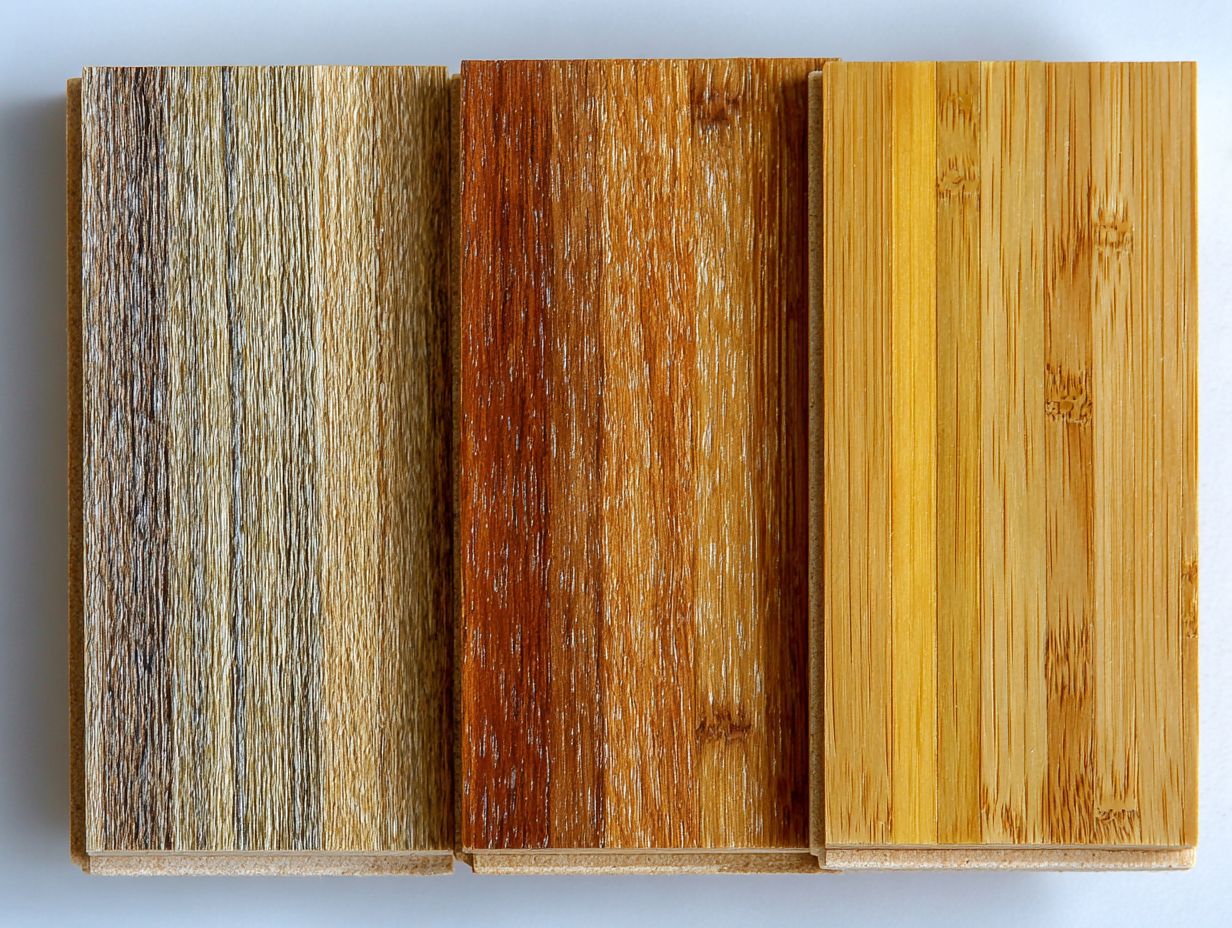
Bamboo flooring is made from bamboo grass and is known for being strong and eco-friendly, providing a green option compared to regular hardwood flooring.
This flooring is primarily made from the fast-growing Moso bamboo, which reaches maturity in just 5-7 years. Its environmental benefits stem from its rapid growth and minimal resource requirements, compared to traditional hardwoods.
Two popular types of bamboo flooring are strand woven and carbonized bamboo. Strand woven bamboo, known for its high density and strength, is ideal for high-traffic areas. On the other hand, carbonized bamboo is darkened using heat, offering a warm aesthetic.
Both types provide a sustainable option without sacrificing style or durability.
Benefits of Bamboo Flooring
Bamboo flooring has many advantages. It is very hard, similar to traditional hardwoods, which makes it a long-lasting and eco-friendly option for contemporary homes.
This eco-friendly material is made from a rapidly renewable resource, growing back in just 3-5 years compared to decades for hardwood trees. Its hardness rating typically surpasses that of oak, providing excellent resistance to dents and wear.
Bamboo flooring is affordable, costing about $2 to $7 per square foot, which makes it a good choice for homeowners looking to save money.
Many bamboo products feature easy installation with click-lock systems, allowing for a DIY approach that doesn’t require professional help. can offer more details on how bamboo compares with traditional hardwoods.
Types of Bamboo Flooring
Bamboo flooring is available in different styles, each having unique features and advantages, helping homeowners choose based on their look and use preferences.
Strand Woven Bamboo Flooring
Strand woven bamboo flooring is created by compressing shredded bamboo fibers, resulting in a highly durable product with a Janka hardness rating that often exceeds 3000.
This impressive hardness makes strand woven bamboo flooring suitable for high-traffic areas such as hallways and living rooms, where traditional hardwoods often struggle.
For comparison, red oak, a common hardwood, has a Janka rating of about 1290, while maple averages around 1450. This significant difference highlights the resilience of bamboo.
Bamboo naturally resists moisture and pests, which means it lasts a long time. This makes it a good choice for homes and businesses.
Horizontal Bamboo Flooring
Horizontal bamboo flooring is produced by slicing bamboo stalks horizontally and pressing them together, resulting in a unique aesthetic and a moderate durability level.
This manufacturing technique gives horizontal bamboo a distinctive appearance, showcasing the natural grain and knots of the bamboo.
In terms of durability, it typically achieves a hardness rating of around 1380 on the Janka scale, which is comparable to oak but softer than some hardwoods like maple.
This flooring works well in both modern and classic designs. Its natural colors can work with various interior designs, making it a popular choice for eco-friendly homeowners who want to keep a stylish look while being sustainable.
Vertical Bamboo Flooring
Vertical bamboo flooring features bamboo stalks pressed vertically, providing a distinct linear appearance and excellent strength characteristics.
This manufacturing method creates a product that looks stylish and modern while being very strong and long-lasting. Compared to strand woven and horizontal bamboo flooring, vertical bamboo is typically more resistant to warping and damage.
Strand woven bamboo is the hardest and most durable choice, while horizontal bamboo has a softer feel and is less stable.
In practical applications, vertical bamboo is suitable for residential settings, including living rooms and bedrooms, balancing beauty and strength effectively.
Strand Woven Bamboo Flooring
Strand woven bamboo is a very strong flooring choice, created using specific manufacturing methods that result in excellent durability.
Manufacturing Process
The manufacturing process of strand woven bamboo involves shredding bamboo, then compressing it under heat and pressure, resulting in an eco-friendly and durable flooring solution.
The process begins with selecting high-quality bamboo, typically Moso, prized for its strength. After harvesting, the bamboo is shredded into small strands.
Next, these strands are soaked in a safe adhesive to improve bonding. The soaked strands are then placed in a hydraulic press at about 2,000 psi and heated to around 200 degreesC.
This intense pressure and heat cure the adhesive, creating a solid mass. This method makes bamboo tougher than many hardwoods and also cuts down on waste, which makes it an environmentally friendly option.
Durability and Hardness
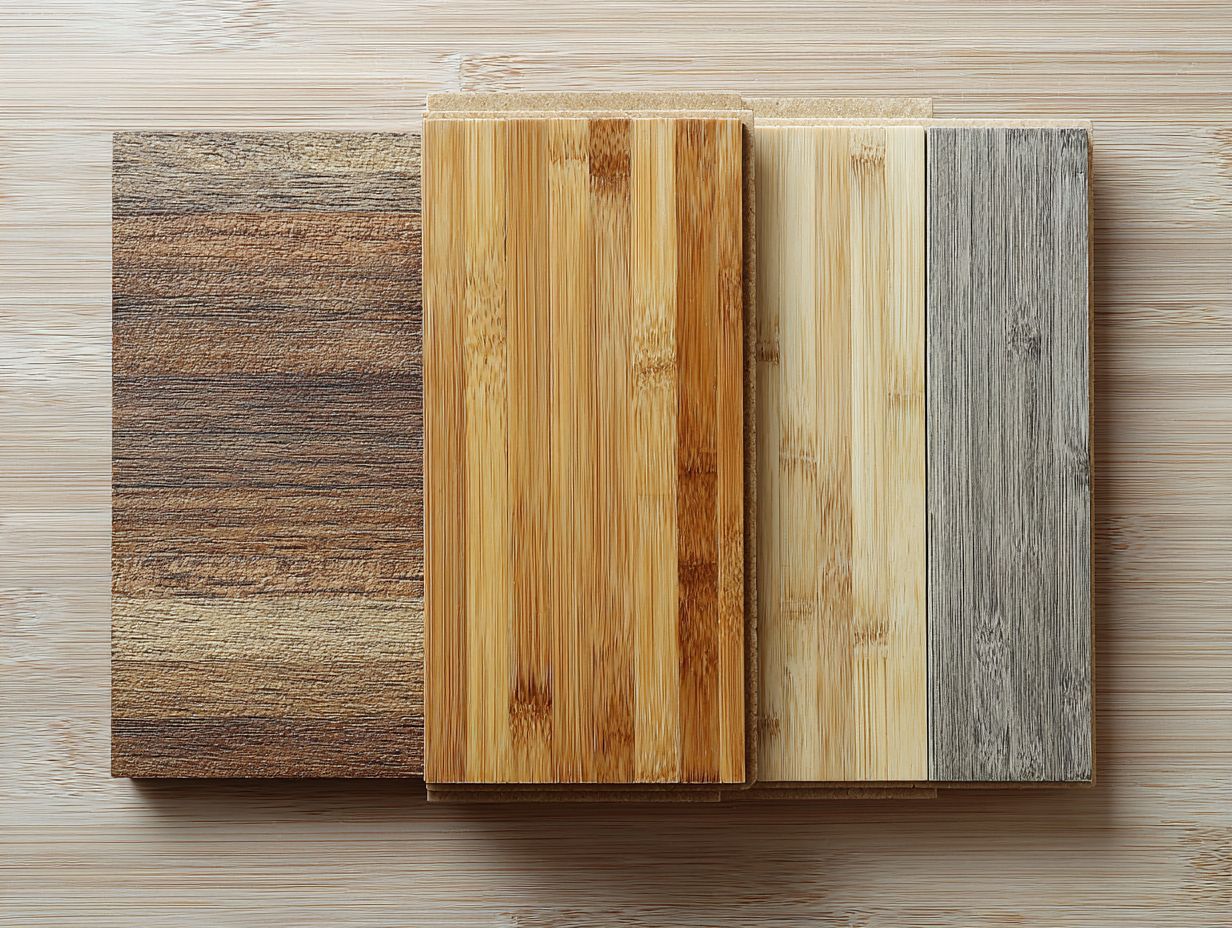
Strand woven bamboo flooring usually has a Janka hardness score of 3000, which means it’s one of the toughest flooring choices and works well in busy areas.
This impressive hardness means strand woven bamboo is less prone to denting or scratching compared to traditional hardwoods like oak (Janka rating of 1290) and maple (Janka rating of 1450).
Homeowners may find this durability particularly beneficial in homes with pets or children. Its resistance to moisture makes it a strong candidate for environments like kitchens and bathrooms where other types of flooring might suffer.
When considering flooring options, homeowners should weigh these performance benefits against factors like cost and maintenance, ensuring a choice that fits their lifestyle.
Appearance and Aesthetics
Strand woven bamboo flooring is available in various finishes, including natural and carbonized options, appealing to diverse design preferences.
Natural finishes showcase the unique grain patterns of bamboo, bringing warmth and a subtle earthy feel to spaces. In contrast, carbonized options introduce a rich, darker hue, which can add sophistication and drama.
Modern homes match nicely with the plain and simple look of natural bamboo, while traditional or rustic designs look better with the deep color of carbonized bamboo.
Both finishes are durable, suitable for areas with a lot of activity.
Cost and Availability
Strand woven bamboo flooring usually costs between $3 to $7 per square foot. The price varies based on quality and where you buy it, but it remains a good choice compared to traditional hardwoods.
To find the best deals, consider shopping at major retailers like Home Depot, Lowe’s, and online platforms such as Wayfair or Amazon.
These stores frequently offer discounts and seasonal promotions. Checking local flooring boutiques might reveal clearance sales or exclusive styles.
Always request samples, and compare the thickness and durability ratings-higher-quality bamboo may cost more initially but deliver greater longevity and resilience.
Watch shipping costs, as they can significantly impact your overall budget.
Horizontal Bamboo Flooring
Horizontal bamboo flooring provides a special look with its unique grain pattern and reasonable strength, fitting well with different design options.
Manufacturing Process
The manufacturing of horizontal bamboo involves cutting stalks into flat planks, which are then glued and pressed to form flooring boards that showcase their natural beauty.
After cutting, the bamboo is boiled to remove sugars and increase durability. This process minimizes pest attraction and prevents shrinking.
Next, the planks are laminated using eco-friendly adhesives, enhancing strength and moisture resistance. The pressed boards are sanded until smooth and then coated with a protective layer, like water-based polyurethane, to improve their look and strength.
Each step, from boiling to final touches, influences the appearance and lifespan of the flooring, resulting in a strong product that withstands everyday use.
Durability and Hardness
With a Janka hardness rating of around 1500, horizontal bamboo flooring is less durable than strand woven options but still offers good resistance to wear and tear.
Strand woven bamboo, with a Janka hardness rating between 3000 and 4000, is very strong, making it ideal for busy areas.
To maintain the longevity of horizontal bamboo, avoid excessive water, as moisture can cause warping.
Regularly sweep or vacuum to remove dirt and debris, and use a damp mop with a pH-neutral cleaner for deeper cleaning.
Consider applying a protective layer every few years to avoid scratches and fading. This helps your flooring stay looking good for longer.
Appearance and Aesthetics
This type of bamboo flooring features a unique appearance characterized by its wide grain patterns and various finish options, including natural and stained varieties.
Bamboo flooring comes in different colors that match various home designs. A natural finish works well with rustic styles, while darker stains suit modern looks.
When choosing bamboo flooring, consider its durability and eco-friendliness; look for a strand-woven option that offers greater resistance to dents and scratches.
To install bamboo correctly, use a moisture meter to check humidity levels since bamboo reacts to changes in humidity.
Bamboo flooring looks good and is useful, fitting well with different room styles.
Cost and Availability
Horizontal bamboo flooring usually costs from $2.50 to $5 per square foot, making it an affordable and attractive choice for many homeowners.
To find the best prices, consider checking with local suppliers, big-box home improvement stores, and online retailers like Lumber Liquidators or Wayfair.
When negotiating, ask for bulk discounts if you’re purchasing a large quantity, and inquire about seasonal promotions or clearance sales.
Be sure to compare the quality; some brands offer warranties or certifications that can save you money on long-term maintenance. This proactive approach can lead to significant savings on your flooring project.
Vertical Bamboo Flooring
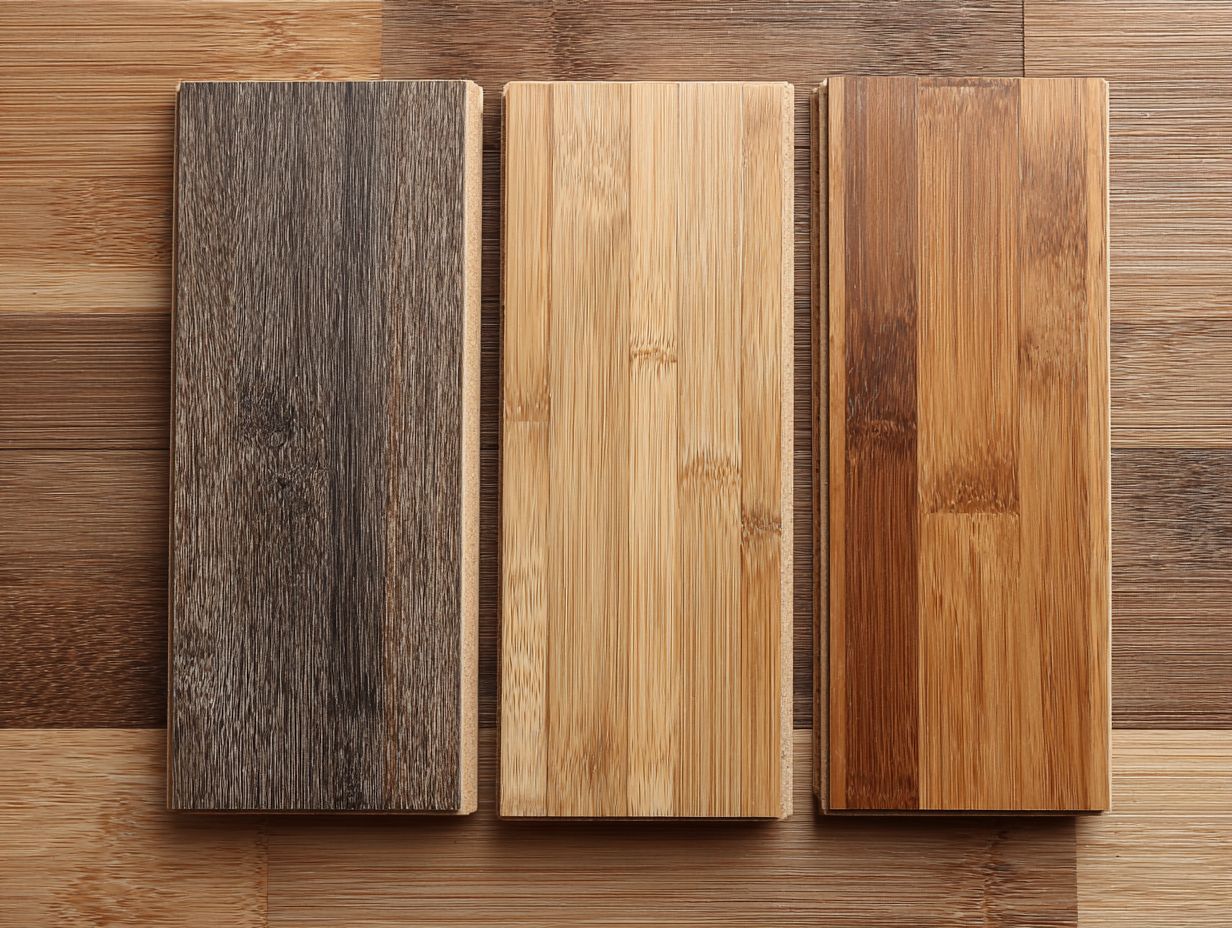
Vertical bamboo flooring provides a clean and modern appearance. It is made of narrow strips that give it a distinct texture and visual appeal.
Manufacturing Process
Vertical bamboo flooring is manufactured by slicing bamboo stalks into thin strips, which are then glued together to form a dense and durable flooring product.
This process results in a flooring option that is notably strong, often surpassing traditional hardwoods in durability.
The vertical alignment of the strips gives the flooring a unique aesthetic, showcasing the bamboo’s natural color variations and growth rings.
Many manufacturers use treatments to improve moisture resistance and minimize warping. For instance, using urea-formaldehyde adhesives can create a stable product ideal for areas with variable humidity.
Such careful attention to both manufacturing techniques and materials contributes to the overall longevity and beauty of vertical bamboo flooring.
Durability and Hardness
Vertical bamboo flooring typically exhibits a Janka hardness rating of approximately 1300, providing good durability for residential applications.
Strand woven bamboo flooring has a rating of about 3000, making it a strong option for high-traffic areas. Horizontal bamboo, on the other hand, sits between the two at approximately 1500.
This variation in hardness affects the suitability of each type for different environments. For instance, homeowners with pets or children may prefer strand woven due to its superior resistance to dents and scratches.
Choosing the right type depends on the specific demands of your living space, balancing aesthetics with performance.
Appearance and Aesthetics
The thin vertical strips of bamboo flooring give a modern appearance and come in natural, carbonized, and stained finishes that improve its look.
Natural finishes offer a light, airy feel, ideal for minimalist designs, while carbonized bamboo introduces a rich, chocolate-brown hue perfect for more traditional spaces.
Stained options provide further customization, allowing homeowners to match their decor effortlessly. When choosing, consider the overall theme of your home: natural for coastal styles, carbonized for rustic aesthetics, and stained for modern chic.
Each finish requires different maintenance levels-natural usually needs regular resealing, while carbonized finishes may require less frequent upkeep. This choice is both attractive and useful.
Cost and Availability
Vertical bamboo flooring usually costs between $3 and $6 for each square foot, which makes it a cost-effective choice in the flooring market.
When purchasing vertical bamboo flooring, consider sourcing options from both local retailers and online platforms like Lumber Liquidators or BuildDirect.
Check for certifications such as FSC (Forest Stewardship Council) to confirm responsible sourcing. Buyers should also request samples to assess color and texture before committing, and compare installation costs, which can add $1 to $3 per square foot.
For DIY enthusiasts, many online tutorials provide step-by-step guidance on installation, which can save labor costs.
Comparison of Bamboo Flooring Types
It’s important to look at the various types of bamboo flooring to choose the best option for your needs.
Bamboo vs Hardwood Flooring Carbon Footprint Comparison
Bamboo vs Hardwood Flooring Carbon Footprint Comparison
Carbon Sequestration: Annual Carbon Sequestration
Production and Durability: Material Maturity
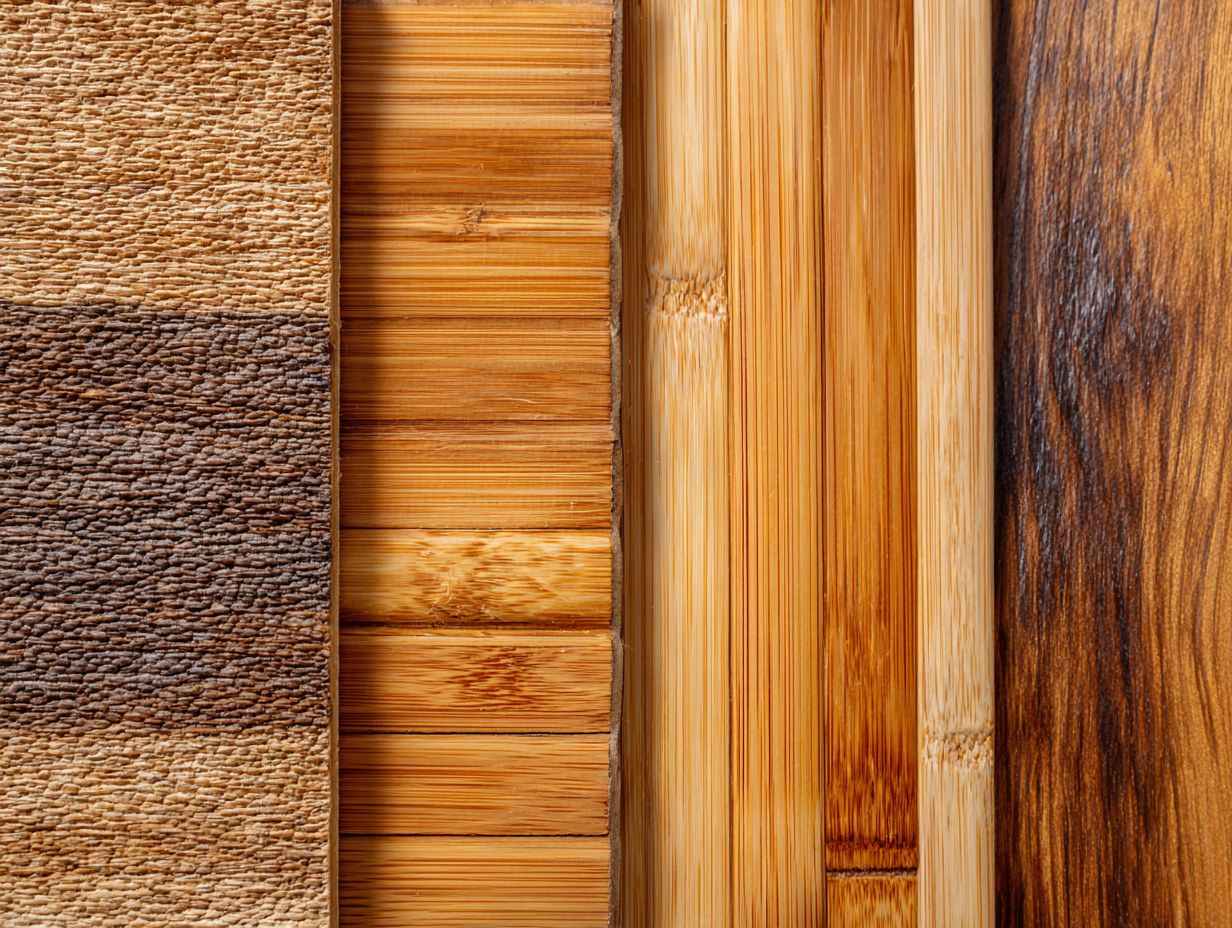
Production and Durability: Flooring Lifespan
The Bamboo vs Hardwood Flooring Carbon Footprint Comparison offers information on how these two common flooring materials affect the environment and practical aspects to consider. By examining carbon sequestration capabilities, maturity rates, and lifespan, we can better understand their ecological and economic implications.
Carbon Sequestration highlights a significant advantage of bamboo over hardwood. Bamboo sequesters 6.88 metric tons of carbon per acre annually, while hardwood sequesters 4.04 metric tons. This represents a 70% increase Bamboo can absorb more carbon dioxide from the air than hardwood, making it a better choice for lowering carbon levels in the atmosphere. Bamboo’s rapid growth and dense biomass contribute to its superior carbon absorption capabilities.
Production and Durability data reveals contrasting characteristics regarding growth maturity and flooring lifespan. Bamboo matures within 5 years, whereas hardwood requires 40 years to reach maturity. This fast growth leads to shorter times between harvests and reduces harm to the environment, improving long-term sustainability. But when thinking about how long the flooring lasts, hardwood flooring lasts up to 125 years, significantly longer than bamboo’s 50-year lifespan. This longer durability means fewer replacements over time, reducing resource use and waste.
- Bamboo’s quick maturity allows for sustainable, rotational harvesting, contributing to ecosystem conservation and economic viability.
- Hardwood’s longevity provides an enduring investment for homeowners, potentially offsetting the slower growth rate through extended use.
In summary, both bamboo and hardwood offer unique benefits. Bamboo takes in carbon well and grows fast, making it a more eco-friendly choice soon. Hardwood, with its long lifespan, provides durability and long-term economic benefits. Deciding between these materials depends on whether you focus on the immediate effect on the environment or the lasting strength and cost.
Strength and Durability
Strand woven bamboo flooring leads in strength and durability with a Janka hardness rating over 3000, while horizontal and vertical variants hover around 1500 and 1300, respectively.
This significant difference makes strand woven bamboo an ideal choice for high-traffic areas, such as living rooms and commercial spaces. For example, if you’re updating a busy cafe, choosing strand woven flooring will help it handle lots of people walking and possible spills.
In contrast, horizontal and vertical bamboo types are better suited for residential settings and less frequently used areas like bedrooms or studies. When selecting bamboo flooring, consider your lifestyle and traffic patterns to choose the right type for your needs.
Cost Effectiveness
In terms of cost-effectiveness, horizontal bamboo flooring is often the most affordable option, while strand woven provides the best value for durability.
When choosing bamboo flooring, consider installation costs alongside material prices. Horizontal bamboo typically costs between $3 and $5 per square foot, offering a budget-friendly choice for homeowners.
Compared to other options, strand woven, costing $5-$7 per square foot, is more durable against dents and scratches, which can reduce repair expenses.
Both types typically need little maintenance, with cleaning and refinishing required every 5-7 years. Over time, the durability of strand woven flooring often offsets its higher initial price, yielding significant savings in replacement costs.
Frequently Asked Questions
What is the difference between strand woven, horizontal, and vertical bamboo flooring?
Strand woven bamboo flooring is made by compressing bamboo fibers together, creating a durable and dense material. Horizontal bamboo flooring is made by laying the bamboo strips horizontally, while vertical bamboo flooring is made by laying them vertically. This results in different patterns and looks for each type of flooring.
Which type of bamboo flooring is the most durable?
Strand woven bamboo flooring is the most durable out of the three types. Its compressed fibers make it harder and more resistant to scratches and dents compared to horizontal and vertical bamboo flooring.
Is one type of bamboo flooring more eco-friendly than the others?
All three types of bamboo flooring are considered eco-friendly because bamboo is a fast-growing and renewable resource. Strand woven bamboo flooring might be better for the environment as it uses most parts of the bamboo plant during production.
Which type of bamboo flooring is best for high-traffic areas?
Strand woven bamboo flooring is the best option for high-traffic areas due to its durability and resistance to wear and tear. It is also less likely to show signs of wear compared to horizontal and vertical bamboo flooring.
Do the different types of bamboo flooring require different maintenance?
Yes, the maintenance for each type of bamboo flooring may differ. Strand woven bamboo flooring may require less maintenance due to its durability, while horizontal and vertical bamboo flooring may need to be refinished more frequently due to their softer nature. It is always best to follow the manufacturer’s instructions for maintenance and care.
Which type of bamboo flooring is more cost-effective?
Horizontal and vertical bamboo flooring tend to be more affordable compared to strand woven bamboo flooring. However, the price can change based on the brand and quality. Check prices and think about how long it will last and how much upkeep it needs before deciding.
